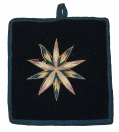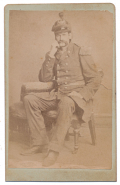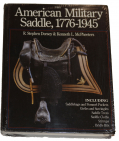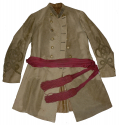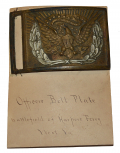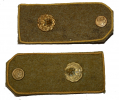site search
online catalog
Search Results
Showing results 1421 to 1440 out of 3064 for sold
GENERAL ROBERT E. LEE GETTYSBURG SOUVENIR FAN
Vintage souvenir fan has a nicely colored image of General Robert E. Lee on cardstock which has been stapled to a wooden stick. Fan measures 8” long by 8” wide at widest points. Stick measures… (2023-3226) Learn More »
US GENERAL SERVICE EAGLE COAT BUTTON RECOVERED AT 3RD CORPS HOSPITAL SITE, GETTYSBURG – KEN BREAM COLLECTION
Dark chocolate patina; has some damage to face – a crack and a few small holes. Some verdigris present. Shank present; more verdigris on reverse. There appears to be a backmark present but it is no… (1163-198A) Learn More »
CONFEDERATE “PIE-PLATE” TIN DRUM CANTEEN
This is an interesting variation on the tin drum canteens that became very popular in the 1850s following the adoption of round drum-shaped tin canteen with convex sides by the US Army in 1836, though… (490-6762) Learn More »
1899 PENSION DOCUMENT – JOSEPH SCOTT, 75TH NEW YORK INFANTRY
3 1/2" x 8" portion of a pension document. Trimmed at top edge. Dated 1899, filled out in ink. Verifies that the soldier, Joseph Scott, was at that time a resident of Riverton, Michigan. Signed by… (1251-17) Learn More »
HARPER’S WEEKLY - MAY 25, 1872
Vol. XVI—No. 804. 24 pp. [401-424], 11” x 15.5, four columns, illustrations and cartoons. Front covers features an 1872 presidential election illustration by famed cartoonist Thomas Nast,… (557-40) Learn More »
HARPER’S WEEKLY—NOVEMBER 22, 1862 [McClellan Relieved of Command!]
Vol. VI—No. 308. 16 pp. [737-752], 15.5” x 11, four columns, illustrations and cartoons. Front features full page illustration of “Hon. Horatio Seymour, Governor Elect of the State of New… (557-30) Learn More »
PENNSYLVANIA STATE COAT OF ARMS CERAMIC SHAVING MUG, POSSIBLY G.A.R.
A nice example of a decorated shaving mug from the 1800s to early 1900s. This one is decorated with gold bands around top and bottom and along the finger loop, and with a full color representation of… (1202-187) Learn More »
VERY NICE E.M DICKENSON SHEFFIELD “INVICTA” BOWIE KNIFE AND SCABBARD
An excellent condition hunting Bowie with staghorn grips and clip-point blade. The grips are excellent, with nice cream and brown color and good surface with no cracks, chips or damage, oval guard,… (2-668) Learn More »
CIVIL WAR US NAVY SAILOR’S EMBROIDERED PINCUSHION OF AMHERST SPOFFORD: SERVICE IN THE 3rd MAINE INFANTRY AND US NAVY
Born in Maine in 1821, Amherst Spofford (III) first went to sea at age thirteen and spent the greater part of his life as a sailor according to a 1916 obituary. During the Civil War he served in both… (2024-358) Learn More »
WWII JAPANESE SWORD KNOT
Shows some storage wear. [gr][ph:L] ~~~~~~~~~~~~~~~~~~~~~~~~~~~~~~~~~~~ THIS ITEM, AS WITH ALL OTHER ITEMS AVAILABLE ON OUR WEB SITE, MAY BE PURCHASED THROUGH OUR LAYAWAY PROGRAM. CLICK HERE… (160-139) Learn More »
WWII JAPANESE SEW ON CAP STARS
Pair of star cap devices which are unissued and still attached together. Excellent condition. [gr] [ph:L] ~~~~~~~~~~~~~~~~~~~~~~~~~~~~~~~~~~~ THIS ITEM, AS WITH ALL OTHER ITEMS AVAILABLE ON OUR… (160-140) Learn More »
WWII JAPANESE MARKSMAN COMPETITION BADGE 2ND CLASS
Pair of badges retain most of their finish, and both are in excellent condition. [gr] [ph:L] ~~~~~~~~~~~~~~~~~~~~~~~~~~~~~~~~~~~ THIS ITEM, AS WITH ALL OTHER ITEMS AVAILABLE ON OUR WEB SITE, MAY… (160-158) Learn More »
WWII JAPANESE SWORD KNOT
Rust colored sword knot is in excellent condition. [gr][ph:L] ~~~~~~~~~~~~~~~~~~~~~~~~~~~~~~~~~~~ THIS ITEM, AS WITH ALL OTHER ITEMS AVAILABLE ON OUR WEB SITE, MAY BE PURCHASED THROUGH OUR… (160-137) Learn More »
MEDAL OF HONOR FOR “EXTRAORDINARY HEROISM” – 1861 PRESENTATION SWORD OF LT. CHARLES JOSEPH MURPHY, 38th NEW YORK, MEDAL OF HONOR FOR BULL RUN, ESCAPEE FROM LIBBY, VOLUNTEER AIDE TO MEDICAL STAFF IN THE PENINSULA CAMPAIGN
This non-regulation officer’s sword bears an 1861 presentation on the obverse scabbard, “Presented to/ Lieut. C.J. Murphy, / by his friends / 1861” and a list of battles on the reverse… (1052-1131) Learn More »
FRANCO-PRUSSIAN WAR ERA CDV
Image is in excellent condition with slight age wear; slight crease on front at right edge. There is an ID on the reverse, “Col ____ng”. [gr] [ph:L] ~~~~~~~~~~~~~~~~~~~~~~~~~~~~~~~~~~~… (160-316) Learn More »
REFERENCE BOOK – THE AMERICAN MILITARY SADDLE, 1776-1945
This book is the first comprehensive coverage of the history of the American Military Saddle using actual photographs and official army drawings of original saddles and other horse equipment. In… (2024-563) Learn More »
CONFEDERATE CAVALRY CAPTAIN’S FROCK COAT OF CAPT. EDWARD BIRD, “EFFINGHAM HUSSARS,” 2nd BATTALION AND 5th REGIMENT GEORGIA CAVALRY
This rare, identified, Confederate cavalry captain’s frock coat belonged to an officer who served from 1861 though 1865, rising from Captain to Colonel, with extensive action especially in… (1179-232) Learn More »
1780 REVOLUTIONARY WAR SATIRICAL “MACARONI” PRINT OF NEW MADE BRITISH OFFICERS BY MARY AND MATTHEW DARLY
The Darlys were a rare husband and wife team of caricaturists and print-sellers, among their other substantial artistic endeavors and were part of the great trade in satirical prints on political and… (2024-350) Learn More »
$395.00
Originally $375.00
MODEL 1851 SWORD BELT PLATE FROM HARPERS FERRY ON A GREAT DISPLAY CARD
This sword belt plate, a very good example of an early pick-up, is mounted on a great old card typical of early relic displays labeled in brown ink, “Officers Belt Plate / battlefield of Harpers… (1202-196) Learn More »
WWII JAPANESE NCO SHOULDER STRAPS
Excellent condition; rank of Sergeant. [gr][ph:L] ~~~~~~~~~~~~~~~~~~~~~~~~~~~~~~~~~~~ THIS ITEM, AS WITH ALL OTHER ITEMS AVAILABLE ON OUR WEB SITE, MAY BE PURCHASED THROUGH OUR LAYAWAY PROGRAM.… (160-135) Learn More »
Showing 1421 to 1440 out of 3064
- Prev
- 1
- 2
- 3
- 4
- 5
- 6
- 7
- 8
- 9
- 10
- 11
- 12
- 13
- 14
- 15
- 16
- 17
- 18
- 19
- 20
- 21
- 22
- 23
- 24
- 25
- 26
- 27
- 28
- 29
- 30
- 31
- 32
- 33
- 34
- 35
- 36
- 37
- 38
- 39
- 40
- 41
- 42
- 43
- 44
- 45
- 46
- 47
- 48
- 49
- 50
- 51
- 52
- 53
- 54
- 55
- 56
- 57
- 58
- 59
- 60
- 61
- 62
- 63
- 64
- 65
- 66
- 67
- 68
- 69
- 70
- 71
- 72
- 73
- 74
- 75
- 76
- 77
- 78
- 79
- 80
- 81
- 82
- 83
- 84
- 85
- 86
- 87
- 88
- 89
- 90
- 91
- 92
- 93
- 94
- 95
- 96
- 97
- 98
- 99
- 100
- 101
- 102
- 103
- 104
- 105
- 106
- 107
- 108
- 109
- 110
- 111
- 112
- 113
- 114
- 115
- 116
- 117
- 118
- 119
- 120
- 121
- 122
- 123
- 124
- 125
- 126
- 127
- 128
- 129
- 130
- 131
- 132
- 133
- 134
- 135
- 136
- 137
- 138
- 139
- 140
- 141
- 142
- 143
- 144
- 145
- 146
- 147
- 148
- 149
- 150
- 151
- 152
- 153
- 154
- Next
Most Popular
Historical Firearms Stolen From The National Civil War Museum In Harrisburg, Pa »
Theft From Gravesite Of Gen. John Reynolds »
Selection Of Unframed Prints By Don Troiani »
Fine Condition Brass Infantry Bugle Insignia »
Large English Bowie Knife With Sheath 1870’S – 1880’S »
Imported (Clauberg) Us Model 1860 Light Cavalry Officer's Saber »
featured item
RARE INSPECTOR MARKED REGULATION MODEL 1850 FOOT OFFICER’S SWORD BY AMES, ID’D TO 11TH US INFANTRY CAPTAIN & LATER BRIGADIER GENERAL JOHN W. AMES
This inspected regulation Model 1850 foot officer’s sword made by Ames. Overall the drawn sword meas. approx. 36.25” long from point to pommel. The blade itself measures 30.00” long with a 20.50” long stopped central fuller and a 15.50”… (2025-3342). Learn More »



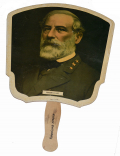
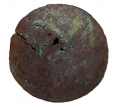
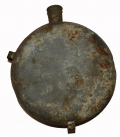
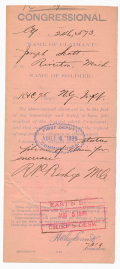
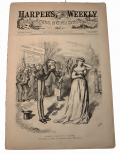
![HARPER’S WEEKLY—NOVEMBER 22, 1862 [McClellan Relieved of Command!]](/images/product/48/211475_tn.jpg)


